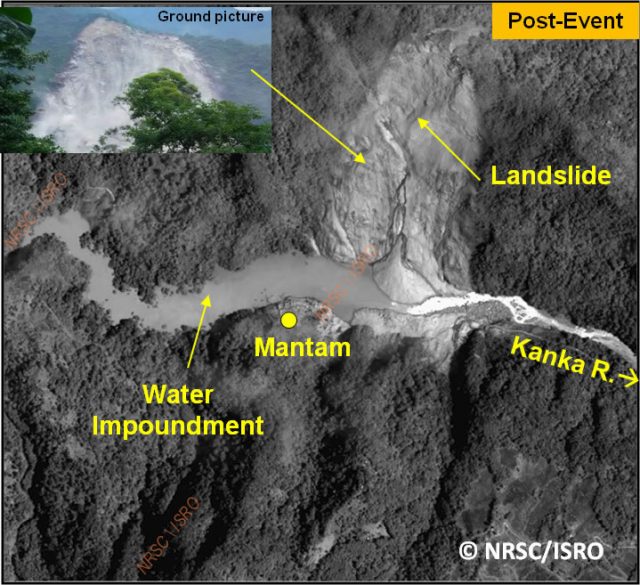19 August 2016
The Dzongu landslide dam: an update
Posted by Dave Petley
The Dzongu landslide dam: an update
It has been good to see that the hazards associated with the Dzongu landslide dam in India are being taken seriously by all involved, even though the water has overtopped the barrier. As I noted earlier, the hazard remains in the landscape, and at this point it is hard to know how likely a breach even might be. The Voice of Sikkim has a good review of current actions:
State Relief Commissioner cum Secretary LRDD Mr. Tsegyal Tashi convened an urgent meeting in his chamber on 18th August, 2016 which was attended by representatives of Central Water Commission, Geological Survey of India and Department of Mines and Minerals. The meeting discussed the landslide at Mantam and the mitigation measures with emphasis on ways and means for safe discharge of water from the dam site without any further loss of time. The priority is to restore the road communication and connectivity cut off areas of three GPUs in Upper Dzongu. While doing so, one must be extremely careful and proper scientific investigations must be undertaken and expert opinion sought before making any interventions at the site in order to avoid the dam bursting and flooding downstream.
This is absolutely appropriate, and an approach that is to be commended. An article in Northeast Today also notes the desire to get expert advice, whilst also emphasising the need to ensure that the affected populations are being assisted appropriately:
The district administration has taken effective and immediate relief and rehabilitation measures. Displaced families were evacuated to safer locations and relief measures were taken on war footing. The Land Revenue & Disaster Management Department has arranged airdrop of essential commodities with Air Force choppers making sorties to transport 7.2 tons of rations and relief materials to Lingdem and Tingvong. Nine persons including two sick children were also evacuated by chopper from Tingvong to Mangan. All the affected people in low lying areas of the upper reaches of the dammed area have been evacuated. The areas downstream have been put on full alert and people residing in lower lying areas en route have been advised to evacuate to safer areas.
That’s not to say that the response has been perfect, most notably there is significant criticism that the relief effort has been too little too late.
Meanwhile the Indian NRSC has released a CARTOSAT (an Indian mapping satellite) image of the landslide:

NRSC Cartosat image of the Dzongu landslide dam
.
The most interesting aspect of this may be what appears to be a secondary failure in the upper potions of the left side (on the image) of the upper part of the landslide, which has built a cone on the landslide mass that appears to be partially constraining the channel. If I was managing the site I’d be keeping a close eye on the landslide itself to determine whether further secondary failures might block the channel.
Two threats remain – first, that the flow is slowly eroding the channel bed, triggering a collapse. This can be a process that develops very slowly, and so cannot be ruled out. The second is how the dam will stand up to the next high magnitude (flood) event. Without better understanding of the dam and channel this cannot be determined.


 Dave Petley is the Vice-Chancellor of the University of Hull in the United Kingdom. His blog provides commentary and analysis of landslide events occurring worldwide, including the landslides themselves, latest research, and conferences and meetings.
Dave Petley is the Vice-Chancellor of the University of Hull in the United Kingdom. His blog provides commentary and analysis of landslide events occurring worldwide, including the landslides themselves, latest research, and conferences and meetings.